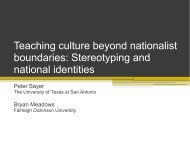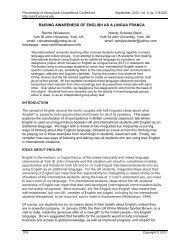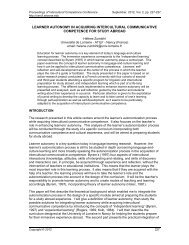BYRAM VERSUS BENNETT: DISCREPANCIES IN THE ... - CERCLL
BYRAM VERSUS BENNETT: DISCREPANCIES IN THE ... - CERCLL
BYRAM VERSUS BENNETT: DISCREPANCIES IN THE ... - CERCLL
Create successful ePaper yourself
Turn your PDF publications into a flip-book with our unique Google optimized e-Paper software.
Paula Garrett-Rucks Byram Versus Bennett<br />
Stage 5—Adaptation: The individual develops the ability to shift his frame of reference to<br />
other culturally diverse worldviews through empathy and pluralism.<br />
Stage 6—Integration: The individual expands and incorporates other worldviews into his<br />
own worldview.<br />
After assessing the participants’ developmental stage at the time of the each posting, I<br />
investigated collective shifts from learners’ ethnocentric thinking (stages 1-3) to enthorelative<br />
thinking (stages 4-6), or vice versa, for each week of the discussion. I also tracked changes in<br />
learners’ development between postings to further investigate peer influences on the shifts in<br />
worldviews in the discussions. In order to investigate the influence of the pedagogical<br />
interventions, I calculated the percentage of ethnocentric and ethnorelative postings for each<br />
phase of the discussion—OLI explicit cultural instruction and authentic texts for Phase 1 and<br />
French informant interviews for Phase 2—with attention to collective shifts between ethnocentric<br />
and ethnorelative thinking. I then situated the discussions within a complex systems theoretical<br />
framework in an attempt to identify the influences on collective shifts in learners’ thinking.<br />
After completing both analyses, I identified instances where learners who had attained threshold<br />
levels of IC within Byram’s model were considered to be using ethnocentric thinking by the<br />
definitions provided in Bennett’ DMIS. I report the types of discrepancies I found when<br />
assessing learners IC using these two different models in the next section.<br />
Discrepancy 1: Learners’ linear development of intercultural thinking<br />
Both Bennett and Byram’s theoretical frameworks speak to the occurrence of a shift in learners’<br />
worldviews. Byram described a threshold level based on learners’ performance of the<br />
objectives for knowledge, attitudes and skills. Bennett claimed that a shift occurs from<br />
ethnocentric to ethnorelative thinking as individuals gain increased awareness and acceptance<br />
of the constructs and experiences of cultural differences in a linear development across the six<br />
stages. Findings from the data analysis of both research questions provided support for<br />
Byram’s threshold hypothesis, but contradictory evidence to the linear nature of IC development<br />
that Bennett claimed in his DMIS. Specifically, when investigating IC emergence at the group<br />
level, I detected inconsistent fluctuations between learners’ ethnocentric to ethnorelative<br />
thinking across each Phase of the three discussions. I also detected nonlinear IC development<br />
at the individual level in my analysis. Within the selection criteria I established to identify<br />
participants’ comments about a specific cultural practice, I detected several instances where<br />
individual learners shifted back and forth from ethnorelative to ethnocentric thinking on a weekly<br />
basis within the discussions, as explained in detail later within this section. Contrary to the<br />
fluctuations that occurred in learners’ IC assessment within Bennett’s DMIS, Byram’s threshold<br />
hypothesis held true for three of the four case studies I conducted as explained below.<br />
Evidence to support Byram’s threshold description<br />
When I situated the data collected for the four focus participants’ experiences within Byram’s<br />
multimodal model of IC, three of the focus participants (Brad, Jack and Lauren) appeared to<br />
have a moment of epiphany when they attained a threshold level of all three components<br />
(attitudes, knowledge and skills) within Byram’s model. Although developmental fluctuations<br />
initially occurred for individual components, these three learners consistently displayed signs of<br />
developed IC after the threshold attainment of all three components. This trend did not hold<br />
true for the fourth focus participant (James), who did not appear to attain a threshold level of<br />
attainment in all three of the areas of intercultural attitudes, knowledge and skills. Interestingly,<br />
<strong>CERCLL</strong> ICC Proceedings 19





